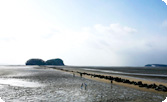World Heritage
Tentative List
- Kangjingun Kiln Sites (1994)
- Mt.Soraksan Nature Reserve (1994)
- Sites of fossilized dinosaurs throughout the Southern seacoast (2002)
- Salterns (2010)
- Southwestern Coast Tidal Flats (2010)
- Daegokcheon Stream Petroglyphs (2010)
- Ancient Mountain Fortresses in Central Korea (2010)
- Oeam Village (2011)
- Naganeupseong, Town Fortress and Village (2011)
- Upo Wetland (2011)
- Seoul City Wall (2012)
- Stone Buddhas and Pagodas at Hwasun Unjusa Temple(2017)
- Gaya Tumuli (2019)
 The Tidal Flats on the southwest coast of Korea, distributed in Gomsoman Bay, Yeojaman Bay, and Hamhaeman Bay (seashores)
and the Sinan archipelagos, are unique macrotidal flats where typical embayed tidal flats turn into open-coast tidal flats during the monsoons. They have no barrier islands like other tidal flats in the Yellow Sea.
During winter, strong waves create sand flats, while in summer, the mud flats expand as tidal currents overpower the waves. The seasonal change is very clear along the coastlines. Although mud flats that develop
in embayed tidal flats are found year-round in the area, monsoons transform the mud flats into sand flats, giving rise to open-coast sand flats on this site. During the course of the year, they shift from mud flats
to mixed flats to sand flats. This distinctive feature of Korean tidal flats on the southwest coast has attracted global attention.
The Tidal Flats on the southwest coast of Korea, distributed in Gomsoman Bay, Yeojaman Bay, and Hamhaeman Bay (seashores)
and the Sinan archipelagos, are unique macrotidal flats where typical embayed tidal flats turn into open-coast tidal flats during the monsoons. They have no barrier islands like other tidal flats in the Yellow Sea.
During winter, strong waves create sand flats, while in summer, the mud flats expand as tidal currents overpower the waves. The seasonal change is very clear along the coastlines. Although mud flats that develop
in embayed tidal flats are found year-round in the area, monsoons transform the mud flats into sand flats, giving rise to open-coast sand flats on this site. During the course of the year, they shift from mud flats
to mixed flats to sand flats. This distinctive feature of Korean tidal flats on the southwest coast has attracted global attention.
The tidal flats on the southwest coast of Korea were created when sediment began to accumulate along the coastline, beginning 7,000 years ago when the Yellow Sea began to level out, ending the rapid rise of the sea level from 20,000 years ago. On the outer parts of the tidal flats, cheniers formed and gradually moved to the seashore. The onshore sand flats possess well-developed sand dunes, and windbreak forests are distributed to protect land under cultivation. Because salterns and rice paddies lay behind the windbreak forests, people have naturally tried to protect pine forests and expand these windbreaks. Their efforts have contributed to preserving the Korean tidal flats. The tidal flats in the southwest of Korea also serve as a stopover for migratory birds flying to Siberia on the East Asia Flyway. The birds feed in the tidal flats and stockpile the energy needed to fly great distances. Annually, about 1 million birds of 300 species stop by this site. In addition, a variety of life forms are found in the southwest tidal flats. It is home to some 150 species of macrobenthos, and the once damaged colonies of halophytes are thriving on the land today. Diverse wild plants and animals live on the islands. Also located in this tidal flats area, Korea's largest salterns produce vast amount of salt.



 >
>